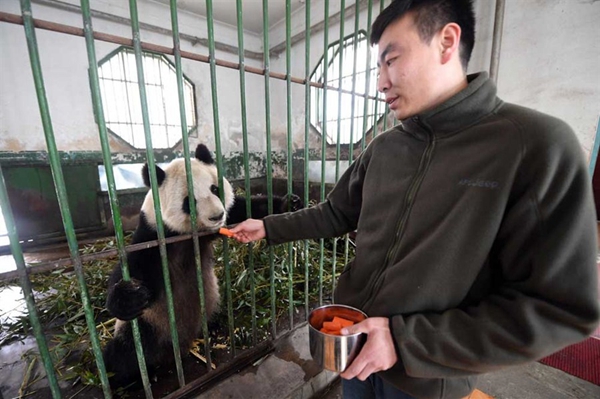|
|
|
Keeper Liu Jiang feeds Shu Lan at a zoo in the northwestern city of Lanzhou. The 23-year-old giant panda, who is 70 in human terms, is to be returned to her hometown in Sichuan Province. [Photo/Xinhua] |
A 23-year-old panda living in a zoo in the northwestern city of Lanzhou is to return to its hometown in southwest China’s Sichuan Province due to its age, zoo authorities said yesterday.
Shu Lan was born in Chengdu, Sichuan’s capital, and moved to Lanzhou in 1996.
In 1999, she went back to Sichuan to live in Chengdu and two giant panda centers in the city of Ya’an for research and breeding.
The panda returned to Lanzhou in April last year, but her health aroused public concern after photographs of her with an injured back and foaming at the mouth went viral.
The China Conservation and Research Center for the Giant Panda sent three experts to Lanzhou earlier this month to evaluate her health and the living conditions at Lanzhou Zoo.
They found that Shu Lan’s health was normal and determined that the foaming at the mouth was caused mainly by chewing and playing with her tongue. But they also pointed out that her weight had dropped from 103 kilograms to 92kg since she had returned to the city, though that was still in the normal range.
However, they also concluded that Shu Lan was showing symptoms of aging.
Giant pandas live mainly in the mountains of northern Sichuan as well as the southern parts of Gansu and Shaanxi provinces.
According to the latest nationwide survey, there are 132 giant pandas in the wild in southern Gansu.
But Lanzhou, in the middle of the province, has a different environment and climate compared with wild panda habitats.
Heating, air conditioning and a humidifier have been installed in Shu Lan’s living area in the zoo. But the panda habitat was built in 1976 and is now deemed too antiquated for her.
The bamboo she was fed was not fresh enough as it was transported from central China’s Henan Province. In addition, the zoo lacks experience in taking care of old pandas.
Experts suggested sending Shu Lan to the China Conservation and Research Center for the Giant Panda in Sichuan to help maintain her health.
That suggestion has been approved by the zoo, though a specific schedule has not yet been released.
The decision was confirmed by Zhang Jianlong, head of the State Forestry Administration.
“We will try our best to improve the condition of the zoo,” said Lei Qinghai, its director, adding that the city is planning to move the zoo to a new site for future development.
A national survey released in February 2015 showed that by the end of 2013, China had 1,864 wild pandas and 375 others living in captivity.
Follow this news feed: HM Government






